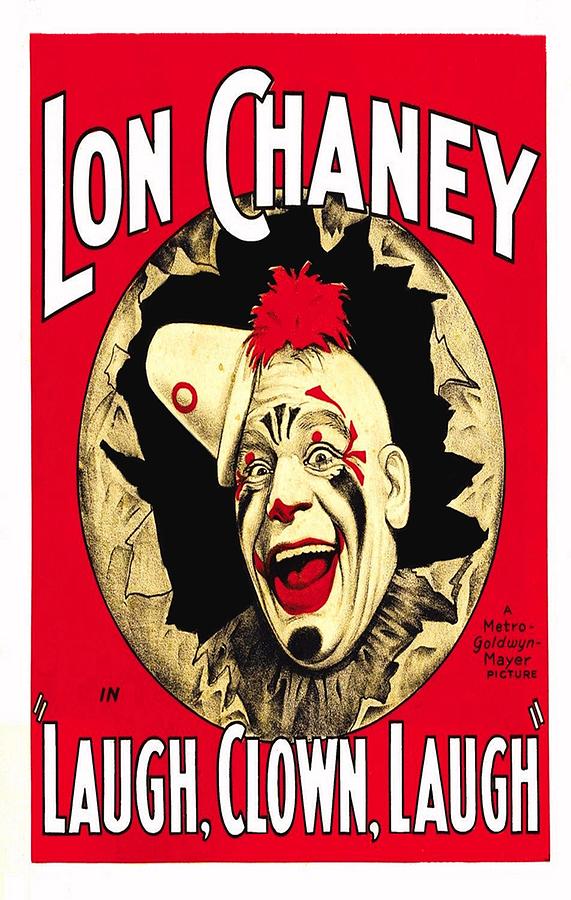Laugh, Clown, Laugh (partially lost Lon Chaney drama film; 1928)
Laugh, Clown, Laugh is an American silent drama film, released on April 14th, 1928. The movie was directed by Herbert Brenon, and starred Lon Chaney and Loretta Young.[1] The film was based on a 1923 Broadway production, which in turn was based on a 1919 Italian play.
Plot
Tito and Simon are a traveling acrobatic clown team in Italy. One day, Tito finds a small girl tied up and abandoned by the river, apparently left by poor parents who could not afford to keep her. Tito wishes to keep her, but Simon insists that "women bring bad luck." Tito flatters him by naming the girl Simonetta and he begrudgingly agrees to let her stay. Years later, Simonetta has become a beautiful young woman who is quickly mastering the tight-rope. Near the circus grounds, Simonetta is caught stealing a rose from the gardens of Count Luigi Ravelli. Luigi is charmed by the girl and brings her in to meet his guests. Tito tells Simon that he wants Simonetta to join the act, but Simon is furious and leaves the act. Three years have passed, and Tito is now a famous clown named Flik. In the office of a famous neurologist, Count Ravelli is being treated for uncontrollable fits of laughter, while Tito is being treated by the same doctor for severe depression, brought on by his unrequited love for Simonetta. Ravelli and Tito decide they might be good for one another, and become friends. Luigi is delighted to be reunited with Simonetta and the three go everywhere together.
One day, Tito sees the police arresting a beggar, and recognizes the man as Simon. The two are happily reunited and they form a new act called Flik and Flok. Luigi sends Simonetta a pearl necklace, and her maid encourages Simonetta to accept his advances, but the girl states that she could never leave Tito. Simon tries to convince Tito that Luigi is trying to bribe Simonetta for dishonorable purposes, and Tito becomes enraged. Tito tells Luigi to "fish in the gutter for harlots" with his pearls, but Luigi shows Tito the note that he sent with the pearls: "They were my mother's pearls--I want them to be my wife's." Tito asks Luigi's forgiveness, but confesses his love for Simonetta. He tells Luigi that if Simonetta accepts him, she will never learn of his love. Luigi's proposal is accepted, and Flik must go on with his act. Simon tells him, "Laugh, clown, laugh. Even though your heart is breaking!" Simonetta and Luigi are betrothed, but she soon returns to Tito and agrees to marry him. Tito is thrilled, but realizes that she is marrying him only for pity, not love. Simon has worked out a new act for Tito where he slides down to the stage on a high wire, sliding on his head with a helmet that fits in the wire. When Tito shows up for rehearsal, he is in full costume and acting obsessed. He climbs the ladder for his act and makes Simon announce him. Tito rolls down the rope, but half-way down he falls. Simon rushes to him, and Tito dies in his arms saying, "Tell Luigi...to be good...to her."[2]
Availability
The film is one of several of Lon Chaney's 1920's films to have survived, and is easily available on DVD. However, the fourth reel of the film is lost, though the footage missing is not said to be too important to the overall story. It is unknown when the reel became lost, but as the film was an MGM film, the last complete copy may have been stored in the MGM vault that caught fire in 1965.
An alternative ending of the film was also shot, in which Flik falls, but is not killed. He tells Simonetta and Luigi that the two of them should be happy together and the camera moves in to a closeup of Tito laughing. The ending was made in attempt to produce a happier ending, and was also apparently available to theatres who didn't like the original ending.[3] Though, it is unsure if the latter part is true.
Gallery
Videos
See Also
- London After Midnight (lost Lon Chaney mystery horror film; 1927)
- The Miracle Man (partially found Lon Chaney drama film; 1919)
External Links
References
- ↑ Silentera listing of the film. Retrieved 09 Mar '23
- ↑ Synopsis from lonchaney.org Retrieved 09 Mar '23
- ↑ IMDB entry about the alternate ending
